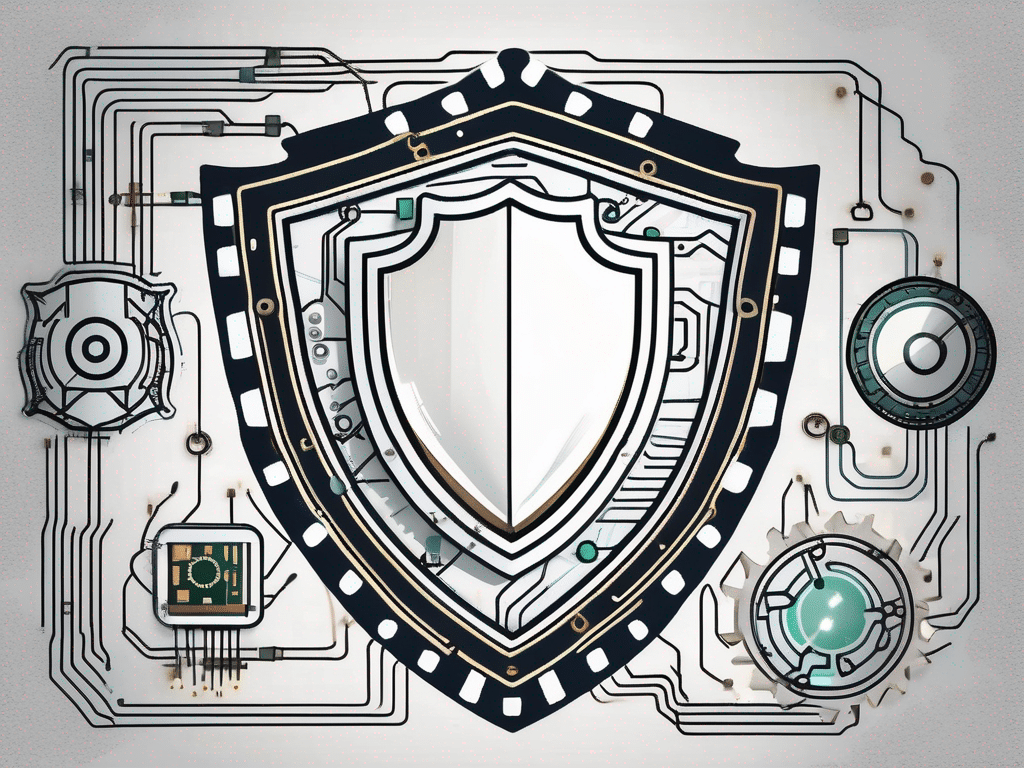Collaborative tech projects have become increasingly common in today’s digital landscape. With teams working together to develop innovative software, apps, and hardware, protecting intellectual property (IP) has become a critical concern. This article explores various strategies to safeguard IP in collaborative tech projects and highlights the relevance of understanding intellectual property rights within this context.
Understanding Intellectual Property Rights
Before delving into the strategies for protecting IP in collaborative tech projects, it is essential to have a clear understanding of intellectual property rights. Intellectual property refers to the legal rights granted to individuals or entities for their creations or inventions. It provides exclusive rights to the creator, preventing others from using, reproducing, or profiting from their work without permission.
Defining Intellectual Property
Intellectual property encompasses various categories, including copyrights, patents, trademarks, and trade secrets. Copyrights protect original works of authorship, such as literary, artistic, musical, or dramatic creations. Patents, on the other hand, grant exclusive rights to inventors of new processes, machines, or designs. Trademarks protect brand names, logos, and symbols, distinguishing products or services from competitors. Lastly, trade secrets refer to confidential business information that provides a competitive advantage.
Importance of Intellectual Property in Tech Projects
In the realm of tech projects, intellectual property holds immense value. It not only encourages innovation and creativity but also enables businesses to maintain a competitive edge. By protecting their IP, tech companies can safeguard their concepts, technologies, or innovations from being copied or exploited by others. This protection fosters a conducive environment for collaboration and allows businesses to monetize their inventions.
Furthermore, intellectual property rights play a crucial role in attracting investors and securing funding for tech projects. Investors are more likely to support ventures that have strong IP protection in place, as it provides assurance that their investment will be protected and not easily replicated by competitors. This added layer of security can give tech startups a significant advantage in the highly competitive market.
Moreover, intellectual property rights also promote knowledge sharing and encourage the growth of the tech industry as a whole. When inventors and creators have confidence that their ideas will be protected, they are more willing to share their knowledge and collaborate with others. This collaboration leads to the exchange of ideas, the development of new technologies, and the overall advancement of the tech field.
Legal Framework for Intellectual Property Protection
To effectively protect intellectual property in collaborative tech projects, it is crucial to understand the legal framework that governs IP rights. Intellectual property (IP) refers to creations of the mind, such as inventions, literary and artistic works, designs, symbols, names, and images used in commerce. The legal framework for IP protection includes various laws and regulations that aim to safeguard the rights of creators and innovators.
One important aspect of the legal framework for IP protection is trade secret laws. Trade secrets are valuable pieces of information that give a business a competitive edge. In collaborative tech projects, partners must take measures to protect trade secrets, such as proprietary algorithms or formulas, from unauthorized disclosure or use. Non-disclosure agreements (NDAs) are commonly used to safeguard trade secrets in collaborative ventures.
Copyright Laws and Tech Projects
Copyright laws play a fundamental role in protecting various aspects of tech projects, such as software, code, designs, and graphical elements. By obtaining copyright protection, creators can prevent others from using or reproducing their work without authorization. Collaborators must ensure that proper copyright attributions and acknowledgments are in place for any shared materials.
Additionally, fair use provisions in copyright law allow for the limited use of copyrighted material without permission for purposes such as criticism, comment, news reporting, teaching, scholarship, or research. Understanding the boundaries of fair use is essential for collaborators in tech projects to avoid copyright infringement claims.
Patent Laws and Tech Projects
Patent laws protect inventions and technological advancements. Collaborative tech projects often involve the creation of innovative solutions or processes that may be patentable. By patenting their inventions, creators can establish legal protection and prevent others from using, selling, or distributing their technology.
It is important for collaborators in tech projects to conduct thorough patent searches to ensure that their inventions are novel and non-obvious before applying for a patent. Patent protection grants inventors exclusive rights to their inventions for a limited period, encouraging innovation and technological progress in collaborative endeavors.
Strategies for Protecting Intellectual Property in Collaborative Tech Projects
Now that we understand the importance of intellectual property rights and the legal framework, let’s explore some effective strategies for protecting IP in collaborative tech projects.
Intellectual property (IP) is a valuable asset in the tech industry, where innovation and creativity drive success. In collaborative tech projects, protecting IP is crucial to safeguarding the hard work and ingenuity of all parties involved. By implementing robust strategies for IP protection, businesses and individuals can ensure that their innovations are secure and their competitive edge is maintained.
Non-Disclosure Agreements
Non-disclosure agreements, or NDAs, are vital tools for protecting sensitive information shared within collaborative tech projects. An NDA is a legal contract that allows parties to share proprietary information while ensuring that it remains confidential. By implementing NDAs, collaborators can establish trust and maintain the secrecy of valuable intellectual property.
NDAs are particularly important in collaborative tech projects where multiple parties are involved in the development process. These agreements outline the terms and conditions of information sharing, specifying what information is considered confidential and how it should be handled. By clearly defining the boundaries of confidentiality, NDAs help prevent unauthorized disclosure of sensitive IP and protect the interests of all parties.
Licensing and Royalties
Another strategy for protecting IP in collaborative tech projects is through licensing and royalties. Licensing agreements allow the creator to grant permission to others to use their technology in exchange for royalties or licensing fees. This approach enables businesses to monetize their inventions while maintaining control over their use.
When entering into licensing agreements, it is essential for creators to carefully define the scope of use and establish clear terms for royalty payments. By setting out these details in a formal agreement, creators can protect their IP rights and ensure that they receive fair compensation for the use of their technology. Additionally, licensing agreements can help creators expand the reach of their innovations by allowing other parties to leverage their technology in new and innovative ways.
Role of Technology in Safeguarding Intellectual Property
Technology itself can also play a crucial role in safeguarding intellectual property within collaborative tech projects. Let’s explore a few technological solutions that can enhance IP protection.

When it comes to safeguarding intellectual property, it’s essential to consider the evolving landscape of cybersecurity threats. As technology advances, so do the methods used by malicious actors to compromise sensitive information. Collaborators must stay vigilant and adopt robust cybersecurity measures to protect their valuable IP assets from cyberattacks and data breaches.
Digital Rights Management
Digital Rights Management (DRM) technologies are designed to control the use, reproduction, and distribution of digital content. By implementing DRM measures, collaborators can protect their software, media files, or other digital assets from unauthorized access or duplication.
Moreover, the implementation of DRM solutions can also enable content creators to monetize their creations effectively. By restricting access to premium content through licensing and encryption, creators can ensure that their intellectual property is used in compliance with copyright laws and licensing agreements.
Blockchain and Intellectual Property
Blockchain technology offers a decentralized and transparent approach to safeguarding intellectual property. By recording ownership and transaction details in a distributed ledger, blockchain can provide immutable proof of creatorship and prevent unauthorized use of IP. Collaborators can explore the use of blockchain-based solutions to establish a trustworthy system for managing IP rights.
Furthermore, the use of smart contracts on blockchain networks can automate the enforcement of IP agreements, ensuring that all parties involved adhere to the terms and conditions set forth in the contracts. This not only streamlines the IP management process but also reduces the risk of disputes and infringement issues among collaborators.
Challenges in Protecting Intellectual Property in Collaborative Tech Projects
While there are various strategies and technologies available to protect intellectual property in collaborative tech projects, certain challenges should be acknowledged.

One significant challenge that arises in collaborative tech projects is the issue of trade secrets. In a collaborative environment where multiple parties are involved, maintaining the secrecy of valuable information can be challenging. It is crucial for project collaborators to establish clear protocols and agreements regarding the handling of sensitive information to prevent inadvertent disclosure.
Globalization and Intellectual Property
In an interconnected world, where collaborative tech projects span across borders, protecting intellectual property can become complex. Different countries have varying IP laws and regulations, making it essential to navigate the legal landscape and secure international protection for IP assets.
Moreover, the rise of outsourcing in tech projects adds another layer of complexity to intellectual property protection. When collaborating with external vendors or partners, ensuring that proper contractual agreements are in place to define ownership rights and usage permissions is crucial to safeguarding intellectual property.
Rapid Technological Changes and Intellectual Property
The fast-paced nature of technology introduces challenges in protecting intellectual property. With constant innovation, it becomes essential for collaborators to stay updated with the latest developments in their respective fields and adapt their IP protection strategies accordingly.
Additionally, the open-source movement presents a unique challenge in collaborative tech projects. Balancing the benefits of open-source collaboration with the need to protect proprietary technology requires careful consideration and strategic planning. Collaborators must establish clear guidelines on how open-source components can be integrated into the project without compromising the security and exclusivity of their intellectual property.
Conclusion
In collaborative tech projects, protecting intellectual property is crucial to foster innovation, maintain competitiveness, and ensure fair recognition and compensation for creators. By understanding intellectual property rights, leveraging legal frameworks, implementing effective strategies, and exploring technological solutions, collaborators can successfully safeguard their valuable intellectual property in a collaborative environment. Despite the challenges, a proactive and multifaceted approach to IP protection can contribute to the success of collaborative tech projects in the long run.


